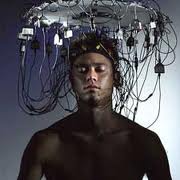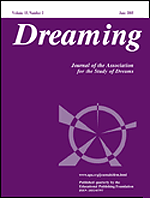Jared Loughner, the alleged gunman in the shooting of Congresswoman Gabrielle Giffords, was fascinated by lucid dreaming and kept a dream journal, according to an interview with Nick Baumann in Mother Jones magazine with Loughner’s close friend Bryce Tierney: “He [Tierney] also describes Loughner as being obsessed with ‘lucid dreaming’–that is, the idea that conscious dreams are an alternative reality that a person can inhabit and control–and says Loughner became ‘more interested in this world than our reality.’ Tierney adds, “I saw his dream journal once. That’s the golden piece of evidence,” the friend said. “You want to know what goes on in Jared Loughner’s mind, there’s a dream journal that will tell you everything.”
Jared Loughner seems to be a mentally ill person plagued by a variety of paranoid beliefs and anxieties. For someone so scared of shadowy, unseen powers, it makes sense that Loughner would consider his dreams (and nightmares?) to be another source of existential danger requiring extreme force to combat and control.
As someone who has devoted considerable time and energy to studying the dream journals of both healthy and mentally disturbed people, I would caution against treating Loughner’s dream journal as evidence to be used against him in a legal proceeding. The metaphoric, multi-layered aspects of dreaming do not allow for interpretations that can be sufficiently precise for courtroom purposes.
I would predict, however, that Loughner’s dream journal will indeed provide a “golden” opportunity to understand his concerns, conflicts, fears, and desires. The recent paper that Bill Domhoff and I wrote in the IASD journal Dreaming on the “Van” dream series showed that a systematic statistical analysis of long-term dream content can accurately identify an individual’s personality attributes, relationships, waking activities, and cultural preferences. (Abstract below.) Our paper builds on lots of previous research indicating that dream content is continuous with many important aspects of a person’s waking life.
A more speculative prediction would be that Loughner’s dreams will contain a high frequency of weapons and physical aggression. Over the years I’ve noticed a few young men who might be described as “loners” having elaborate dreams of using very specific weapons to fight their enemies. As Domhoff and I found with the Van series, the influence of video games may play a role here. I don’t know if Loughner played video games, but either way I’m guessing his dreams will reflect a familiarity with, and enthusiasm for, various kinds of weaponry.
Update 1-12-11: Today’s New York Times includes an interview with another of Loughner’s friends, Zane Gutierrez, which confirms that the alleged killer took great interest in his dreams:
“[E]very day, his friend said, Mr. Loughner would get up and write in his dream journal, recording the world he experienced in sleep and its possible meanings. ‘Jared felt nothing existed but his subconscious,’ Mr. Gutierrez said. ‘The dream world was what was real to Jared, not the day-to-day of our lives.’ And that dream world, his friend said, could be downright strange. ‘He would ask me constantly, “Do you see that blue tree over there?” he would admit to seeing the sky as orange and the grass as blue,’ Mr. Gutierrez said. “Normal people don’t talk about that stuff.'” (p. A14)
The mention of synesthesia (the merging of sensory qualities) adds more detail to the general impression that Loughner suffers from severe mental instability. Likewise, his solipsism (only I truly exist) indicates a possible breakdown in the ability to distinguish between waking and dreaming realities.
Religious mystics, particularly in Hindu, Buddhist, and Daoist traditions, have frequently questioned the boundaries of waking and dreaming (e.g., Zhuangzi’s paradoxical “butterfly” dream) as a way of opening the mind to new possibilities and expanding one’s sense of compassion for all forms of life. That does not seem to be the path Loughner followed. The evidence so far suggests he tried to control his dreaming reality as a way of fighting off the painful, confusing pressures of waking reality.
A warning from Plato’s Republic comes to mind: “[T]he most evil type of man is…the man who, in his waking hours, has the qualities we found in his dream state.” (IX.576.b)
Abstract for “Detecting Meaning in Dream Reports: An Extension of a Word Search Approach”:
Building on previous investigations of waking-dreaming continuities using word search technology (Domhoff and Schneider 2008, Bulkeley 2009a, 2009b), this article demonstrates that a blind analysis of a dream series using only word search methods can accurately predict many important aspects of the individual’s waking life, including personality attributes, relationships, activities, and cultural preferences. Results from a study of the “Van” dream series (N=192) show that blind inferences drawn from a word frequency analysis were almost entirely accurate according to the dreamer. After presenting these findings we discuss several remaining shortcomings and suggest ways of improving the method for use by other researchers involved in the search for a more systematic understanding of meaning in dreams.
Keywords: dreams, content analysis, word search
(Domhoff and Schneider 2008; Bulkeley 2009, 2009)
Bulkeley, Kelly. 2009. The Religious Content of Dreams: New Scientific Foundations. Pastoral Psychology 58 (2):93-101.
———. 2009. Seeking Patterns in Dream Content: A Systematic Approach to Word Searches. Consciousness and Cognition 18:905-916.
Domhoff, G. William, and Adam Schneider. 2008. Studying dream content using the archive and search engine on DreamBank.net. Consciousness and Cognition 17:1238-1247.
 What are the best science fiction and fantasy stories featuring dreams? I’m writing an entry on this question for a new encyclopedia, and I’d appreciate any suggestions of authors and titles to include. I’ll surely say something about Robert Louis Stevenson, Lewis Carroll, Edgar Allen Poe, H.P. Lovecraft, Jorge Luis Borges, Ursula K. LeGuin, Philip K. Dick, Neil Gaiman, J.K. Rowling, and Graham Joyce. (Movies are covered in another entry, which is actually a relief since I’ve only got 750 words.) Who else should be on the list?
What are the best science fiction and fantasy stories featuring dreams? I’m writing an entry on this question for a new encyclopedia, and I’d appreciate any suggestions of authors and titles to include. I’ll surely say something about Robert Louis Stevenson, Lewis Carroll, Edgar Allen Poe, H.P. Lovecraft, Jorge Luis Borges, Ursula K. LeGuin, Philip K. Dick, Neil Gaiman, J.K. Rowling, and Graham Joyce. (Movies are covered in another entry, which is actually a relief since I’ve only got 750 words.) Who else should be on the list?



![62242_cov[1]](https://www.bulkeley.org/wp-content/uploads/2011/01/62242_cov12-200x301.jpg)